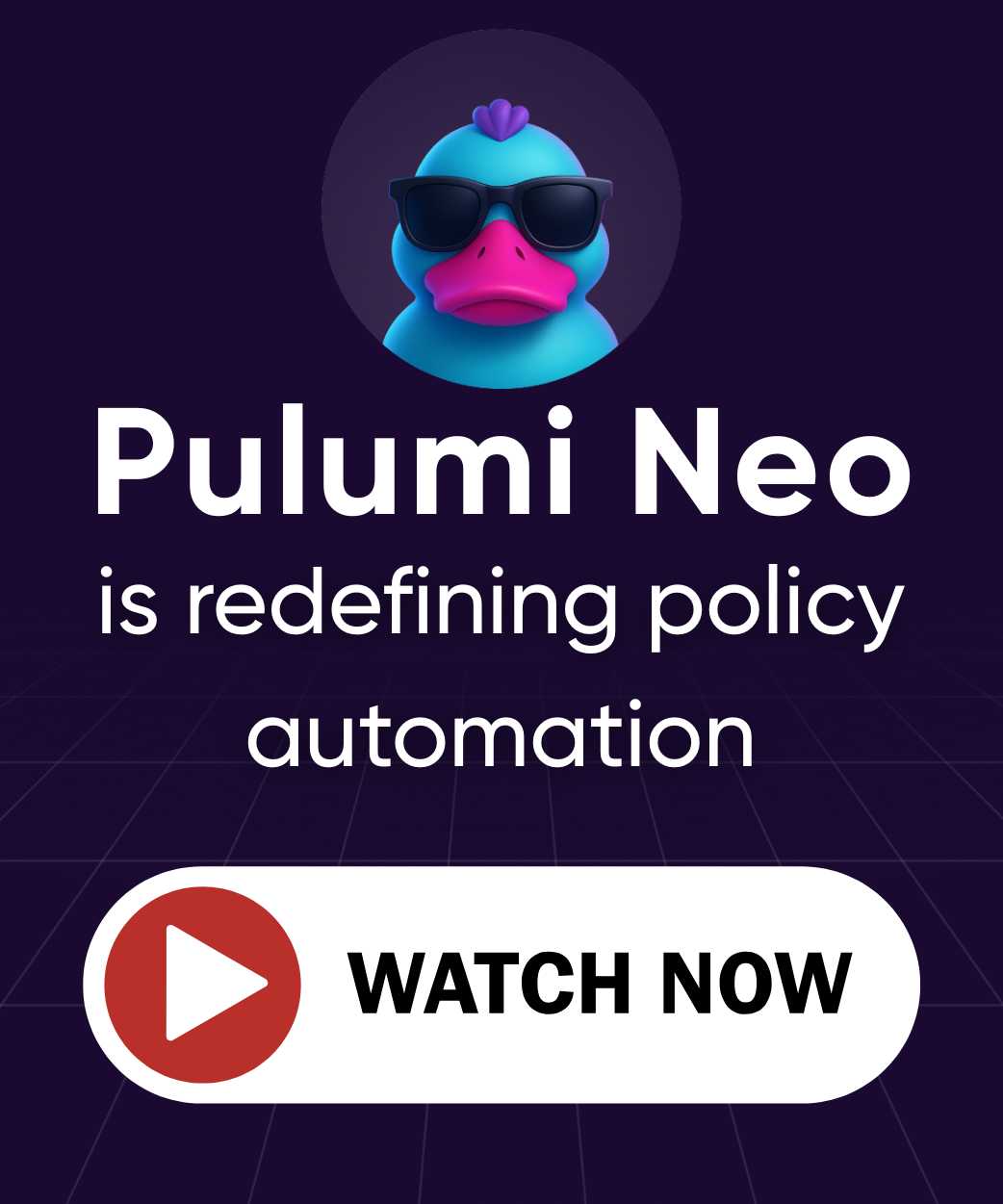Grounded AI: Why Neo Knows Your Infrastructure
Posted on
Ask a generic LLM to “fix my broken deployment,” and you’ll get generic advice. Ask Pulumi Neo the same question, and you’ll get a fix plan grounded in your actual infrastructure state.
The difference isn’t about better prompts or newer models. It’s about what the AI actually knows. Generic LLMs have been trained on the internet. Neo has been trained on your infrastructure.
This distinction matters more than you’d think.
The grounding problem
Most AI tools treat infrastructure like a text generation problem. You describe what you want, the model produces code, and you hope it works.
This approach fails more often than it succeeds because the AI has no connection to your actual infrastructure. It doesn’t know what resources you’ve already deployed, what dependencies exist, or what policies you need to follow. It’s generating code from patterns it learned on the internet, not from understanding your environment.
Pulumi Neo takes a different approach. It’s trained on your infrastructure context: your programs, your state, your resource relationships. When you ask Neo about drift, it doesn’t guess. It queries your actual deployment history. When it suggests a fix, it reasons from your program graph, not generic examples.
Neo doesn’t just autocomplete code. It understands state, resources, dependencies, and cloud behavior. When something fails, Neo explains why, not just what.
This is what makes it grounded AI: it’s anchored to the reality of your infrastructure, not floating in a sea of internet-trained probabilities.
What makes Neo different
The foundation matters more than you’d think.
Traditional AI tools fail in DevOps because they operate in a vacuum. Ask a generic LLM to “fix my broken deployment,” and you’ll get generic advice that ignores your specific infrastructure, your state, your constraints.
The difference with systems like Pulumi Neo comes down to what powers them: not just data, but context.
Think of it this way: a data lake is a massive repository of information sitting inert, waiting to be queried. A context lake is something else entirely. It’s a structured repository that aggregates knowledge about your domain and feeds it to AI systems.

A context lake contains things that matter:
Your infrastructure programs, resource definitions, API schemas, service dependencies. In Pulumi’s case, this includes your program graph, component models, stack configurations.
Real-time metrics, deployment history, drift detection, policy violations. The live pulse of your infrastructure as it actually runs in production.
Ownership information, compliance policies, access controls, quality signals. The organizational context that determines what changes are safe, who can make them, and why they matter.
Pulumi’s approach builds on this principle. Your infrastructure programs, state files, resource metadata, policy definitions. All of this becomes queryable context. Neo doesn’t hallucinate solutions because it’s grounded in your actual infrastructure. It knows what you’ve deployed, how resources relate to each other, what dependencies exist, what’s drifted.
This is the architectural shift that makes AI-powered DevOps actually work. AI agents are only as effective as the context they can access and the guardrails you have in place to keep them in check. You’re not just automating actions anymore. You’re automating understanding.
Grounded reasoning in practice
Early DevOps automated actions. Modern AI agents automate decisions. But grounded AI does something different: it automates understanding.
When you combine observability data, infrastructure-as-code programs, and deployment history into a context lake, the AI doesn’t just predict what might happen. It reasons about what is happening based on your actual infrastructure state.
Neo can watch infrastructure drift, identify whether it stems from a manual change or a misconfigured resource, and generate a fix plan that maps back to your Pulumi program. That feedback isn’t guesswork. It’s grounded in the same infrastructure metadata developers already use. The context lake ensures Neo isn’t making probabilistic predictions. It’s reasoning from your specific infrastructure truth.

This is what separates grounded AI from generic LLMs. Neo doesn’t just automate deployment. It understands the intent behind it.
The human layer stays critical
Grounded AI doesn’t replace engineering judgment. Every engineer who’s tried to prompt a generic LLM to “write a Pulumi program for me” knows how quickly hallucinations creep in. You still need human context: the judgment to choose the right platform, the discipline to model dependencies, the awareness of compliance and cost.
That’s where grounded AI like Neo fits best. It’s not a chatbot for infrastructure. It’s an extension of your own reasoning.
Neo learns from the same program graph and state data you already manage, drawing from a continuously updated context lake of your infrastructure reality. Its recommendations stay grounded in your environment, not floating in a generic prompt window trained on the public internet.
The opportunity isn’t about replacing engineers. It’s about creating smarter feedback loops between human expertise and AI that actually understands your infrastructure.
What grounded AI enables
The first generation of DevOps automated deployment. Grounded AI automates understanding.
Infrastructure becomes queryable. AI-powered observability correlates incidents before they cascade. CI/CD becomes continuous reasoning rather than continuous execution. Platform teams spend less time fighting YAML and more time guiding systems that reason alongside them.
The context lake architecture makes this possible. Instead of static documentation and scattered tribal knowledge, your infrastructure context becomes something AI agents can actually query and reason over.
Grounded AI won’t replace engineers. But it will change what engineering means: less time translating intent into YAML, more time reasoning about systems at a higher level.
Try it yourself
Want to see what infrastructure cognition looks like in practice? Get started with Neo and ask it about your infrastructure. Watch it reason through drift detection, generate fix plans, or explain complex resource relationships in plain English.
Neo is available today for teams using Pulumi Cloud. The cognitive layer isn’t coming. It’s already here.

